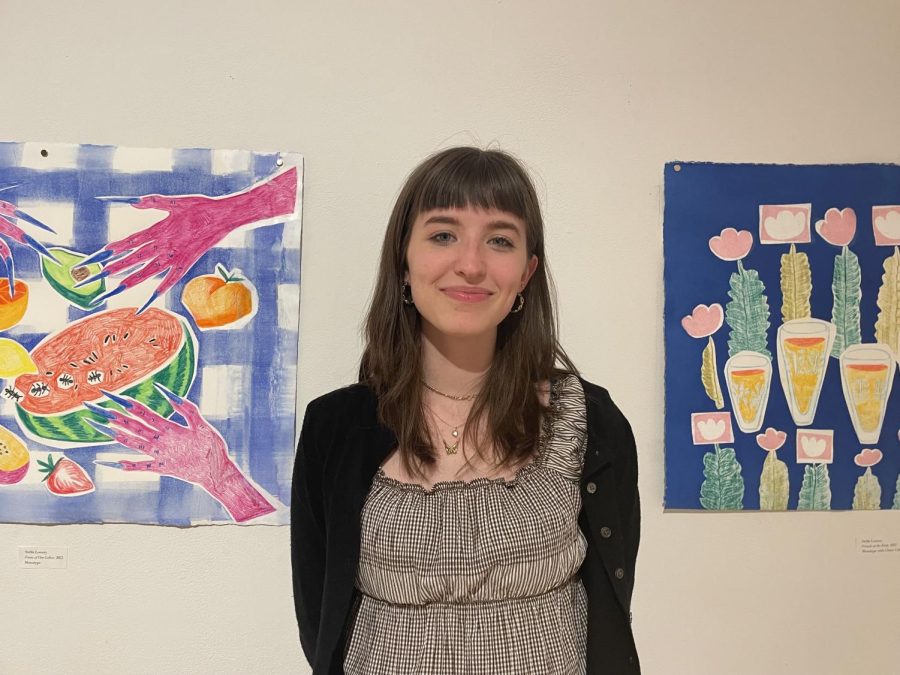“Ripe and Rotting” is cute, colorful and a little bit creepy
Lowery’s exhibit consists primarily of monotypes, or unique, non-reproducible prints.
November 7, 2022
Smith Gallery’s most recent exhibit is a riot of lush, whimsical textures and colors, but beneath its vivid and playful exterior lies traces of something sinister.
“Ripe and Rotting” is the crown jewel of Stella Lowery’s `24 semester-long printmaking independent study under the advisory of Matthew Kluber, professor of studio art. Lowery took a printmaking course during her second year at Grinnell, and when she could not fit art seminars into her schedule, she applied for the independent study opportunity.
The works displayed in “Ripe and Rotting” are monotypes, a unique subfield of printmaking with a singularity that defies the signature replicability of techniques like stencil and relief printing, in which an artist can reprint a design multiple times. In contrast, monotypes result in just one print and its ‘ghost,’ a fainter impression left by residual material applied to the printing surface.
The pieces in “Ripe and Rotting” were created through water-based printmaking processes using transfer, stencil and chine collé techniques.
Lowery studied chine collé and stencil monotype techniques during her internship at the Manhattan-based Robert Blackburn Printmaking Institute during the summer of 2022. During her time at the institute, she studied under Karen Lederer, a Brooklyn-based artist who taught a class on stencil-based printmaking. “I started asking her, ‘what other stuff can I do with this?’” said Lowery. From there, Lowery moved toward exploring transfer monotypes.
“I was constantly making stuff. Even if I wasn’t trying to make a new piece and was hitting a wall, I was changing gears and trying to make a new project every week.”
“I would try and run with an idea until I was running dry, and never stopping, to be honest,” said Lowery. Her commitment to near-constant innovation and creation is evident in the show — hands and mouths, recurring themes in the exhibit, are two of the motifs that Lowery began working with during this time.
Lowery’s bright and spunky pieces are effortlessly eye-catching. Upon further inspection, a viewer may realize that not all is as it seems. In “Welcome to the Party” and “Fruits of Our Labor,” beady watermelon seeds spiral out into a trail of ants.
A measure of double entendre and surrealism extends throughout the entire exhibition. While all of the works share a juicy vibrancy, first appearances are deceiving.
In “Welcome to the Party ” and “Fruits of our Labor,” slender purple hands (one of Lowery’s signature motifs) reach out for and pinch ruby-red grapefruits — are those artfully manicured nails or talons?
“I really like to focus on traditionally feminine imagery in the art I make. Work that is very cute-looking but then also has this vulgar imagery, if I’m being honest,” said Lowery.
Lowery holds the theme of “fleeting femininity” at the core of her works. Ripe fruit is evanescent, reveled in, sunk into, indulged in one moment before being discarded moments after its prime.
“Friends at the Party,” a monotype and chine collé piece surrounded by delicately pressed baby-pink tissue paper flowers, recalls bright mornings, tea parties and the youthful sweetness of freshly pressed orange juice.
In “Glass Half Full,” pearly teeth open for a crush of purple grapes, unaware of the wine about to splatter down from a clinking pair of glasses above.
The woman at the center of “Nesting and Hatching” looks out in resigned horror as spiders weave out of a web and into her hair, an inevitable evolution that will soon catch her, too — a chapter in the ever-present cycle of beauty and decay that “Ripe and Rotting” so masterfully encapsulates.
“Ripe and Rotting” opened in the Smith Gallery in the Joe Rosenfield Center on Friday, Oct. 28.

















































